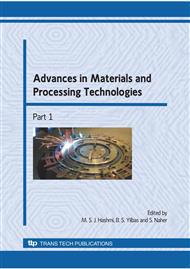p.133
p.143
p.150
p.157
p.165
p.174
p.182
p.190
p.198
Temperature Changes with Die Profile in Axisymmetric Forward Extrusion Process
Abstract:
Temperature effect due to varying die opening shapes in the direct extrusion of lead have been numerically simulated and presented. Using upper bound method of analysis the internal heat generation due to plastic deformation and frictional heat at various stages of the extrusion process for different die opening geometry are simulated. A C++ program simulates the deformation and frictional power at die land region which is converted to temperature change using finite difference program. At the extrusion die land region, temperature rises with increasing complexity of die openings geometry with I-shaped section, giving the highest temperature rise, followed by T-shaped section, rectangular, circular shaped die openings with square section die opening, giving the least temperature rise for any given extrusion parameter. The die land zone shows increasing temperature rise with increasing friction coefficient, while increasing friction coefficient has no overall effect on the dead metal zone temperature rise. The proper choice of die land is, therefore, imperative if excessive generation of heat at the emergent section is to be avoided to maintain good quality and metallurgical structure of the product.
Info:
Periodical:
Pages:
165-173
Citation:
Online since:
December 2009
Authors:
Price:
Сopyright:
© 2010 Trans Tech Publications Ltd. All Rights Reserved
Share:
Citation:


